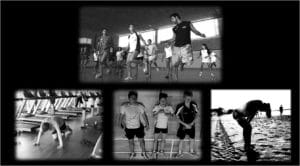Strategies to help when dealing with an injury

Ben Caldwell
Don't waste the recovery time
Focus on other parts of your development and parts of the body. Example if you have a shoulder injury (like I did) then develop your leg strength and endurance through physical training in the gym. Use the time to develop your footwork through shadow badminton.
- Look into other areas like sports psychology if you can’t get on court then work your brain – mental rehearsal (play in your head and improve that way).
- Watch some players on video and learn more about tactics and how they play and win.
- Make notes about things you want to develop when you are back on court.
- Do some long term planning about tournaments, development, long term goals. Use the time to think about your future career beyond badminton or to focus more energy on your university studies.
- Lastly, be patient with your mind and body and the healing process but also be open and explore as many methods of recovery until you find one that works for your specific issue, for example, see more than one doctor or physio, also see an osteopath etc.
Doing some or all of the things will help you come back stronger in body, mind and approach to your play.

Martyn Lewis
Don't sit still and do nothing
Immediately, get yourself to a physio as soon as you can and then make sure you stick to the rehab exercises given. Make sure you get a plan and understand it.
Never just rest!!!!
Injury is normally a good time to reflect, analyse your game as it's likely you will have a different mindset than when you are fully fit.

Jeff Tho
The first 48-72 hours are VERY important
Make sure you ice regularly and use compression. I've found that recovery time is a lot faster if you take care of it from the very beginning.
From that point, work with health care professionals who understand your body. You may need to trial a few different people or professions to work out which works the best for you. For me, the combination of chiropractic care and remedial/deep tissue massage helped me recover the fastest.
From there, make sure you stay diligent with your rehabilitation program. Yes, it's boring. And yes, you might feel like it's already healed but the program is there for a reason and the last thing you want to do is be slack with your rehab, or increase your load too quickly as this can result in re-injury.
Here's a free eBook which is specific for badminton: https://www.volantwear.com/pages/free-badminton-gym-program
Lastly, do pre-hab work. That is, strength/training which heaps in the prevention against injuries.
Listen to this podcast to hear from an Exercise Physiologist who specialises in musculo-skeletal biomechanics.

Jurgen Van Leeuwen
I take a break and regroup and think about the strengths in my game
Don’t panic and make sure you make your opponent have to win their points by not giving away any unforced errors

Daphne Ng
Injury is a worse nightmare an athlete would ever imagine
If you don't cope well with it, serious depression might occur. Injury may seem unfair for an athlete who has been physically active, fit and strong all the while.
It is important to get over the negativity and be mentally tougher to cope with this setback.
Accept the reality, learn about the injury, have the mindset that rehab is also part of training and you have to try to keep as fit as you can. Strengthen the areas that you can train.

Richard Vaughan
Always better not to get injured 🙂
a. Visualisation and mental preparation - training sessions with eyes closed to focus on technical competencies
b. Pool sessions, swimming, or aqua jog - various forms of training in the pool. Anything from endurance to interval work.

Tracy Hallam
Olympic Qualifying and I was injured
My most serious injury which required ankle surgery was a real battle to get my head around. I always felt that if I ever needed surgery, I would not be playing badminton afterwards as I felt my body was going to be a lot weaker and therefore, I was never going to perform at my best so the obvious choice was to quit.
The first month after surgery I was in quite a dark place thinking that badminton was over.
But it seems I was wrong about that. 2 weeks after surgery I was back to the National centre to begin rehab once I got back there I could do some training and also receive physio and things were looking a lot better.
I ended up speaking with psychologists to get me back to the court. It came out that I couldn't bare to look at the scar as it was a symbol of weakness to me but they suggested that I try to massage the scar to try and accept it.
In terms of returning to moving around the court as it was coming up to Olympic Qualifying all I wanted to do mentally was to keep moving forwards in terms of what I was able to do on court. If I wanted a shot at qualifying, I felt I didn't have an option to have a further injury as this would have put me behind schedule and given my rivals more of a head start as being out for about 5 months the world ranking was taking a hit and I would always be clawing it back.
Fortunately, it all worked out

Jordan Hart
Stay active in body and mind and plan your recovery
I have had a few injuries throughout my career. One that needed surgery. I guarantee that nearly all athletes feel frustrated and helpless when they suffer an injury. But for me, I have learned to find the things you can do rather than the things you can’t.
You only have to look at Carolina Marins return from injury to see that the worse thing is just to sit at home and do nothing. I have seen clips from her new Amazon Prime documentary where she is sat on chairs practising lifts or net shots.
More recently Victor Axelson improvising with one leg bike circuits or hand bikes because the best players are the ones that improvise and adapt.
I wish I knew this information when I was younger but I guess it’s only something you learn from experience or if you have someone with the knowledge to help you with the return to court. It’s so difficult to be in a badminton environment all day every day and then get injured and remove yourself from it. Inevitably it’s even harder to return so keep yourself in and around it.

Thanks to everyone for their time and considered thoughts
If you'd like to read more about how to prevent badminton injuries and prevention then click this image and see if you agree with me 🙂
If you'd like to join this expert team and start sharing your knowledge, send me a message and I'll send you some questions
Thanks to everyone for their time and considered thoughts
If you'd like to join this expert team and start sharing your knowledge, send me a message and I'll send you some questions

Don't forget to click here to see a list of all the questions

Martyn Lewis

Tracy Hallam

Jeff Tho

Jurgen Van Leeuwen

Ben Caldwell

Daphne Ng

Jordan Hart

Richard Vaughan






